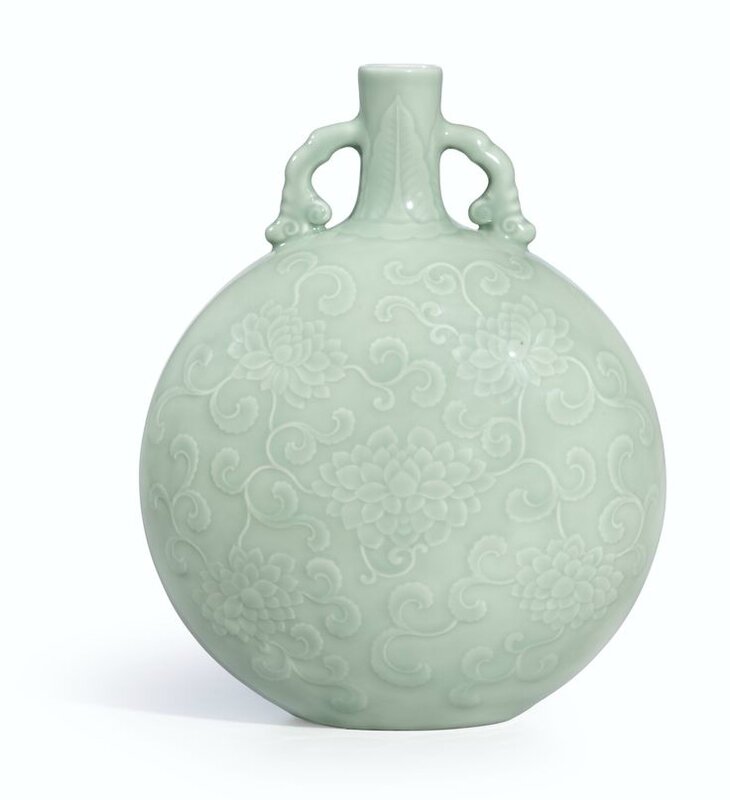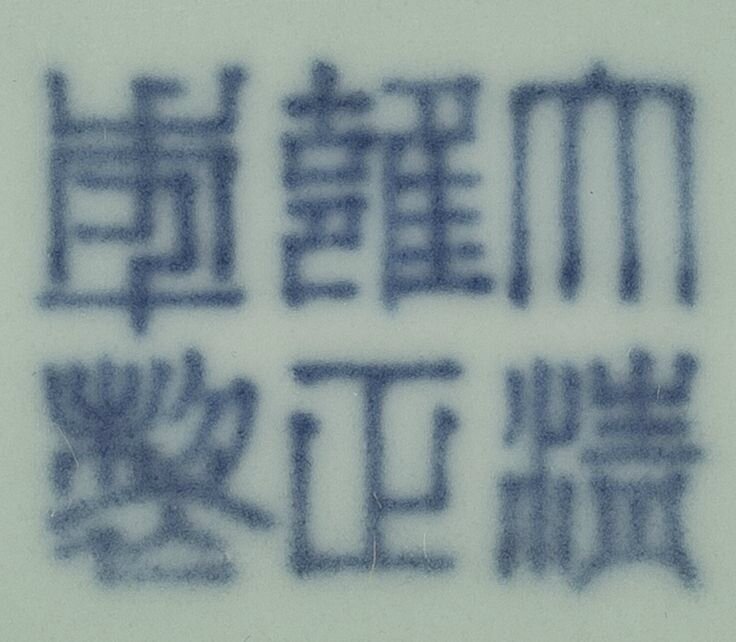A magnificent and very rare carved celadon-glazed moonflask, Seal mark and period of Yongzheng (1723-1735)
Lot 114. A magnificent and very rare carved celadon-glazed moonflask, Seal mark and period of Yongzheng (1723-1735); 29.1 cm., 11 7/8 in. Estimate 12,000,000 — 15,000,000 HKD (1,368,190 - 1,710,238 EUR). Lot sold 20,480,000 HKD. Photo: Sotheby's.
superbly potted with gently rounded sides, the circular body rising from an unglazed footring to a cylindrical neck flanked by a pair of scrolling ruyi handles, finely carved on each side with five luxuriant lotus blooms amid scrolling feathery leaves, the neck encircled with upright leaf lappets above a scrolling band, the attractive glossy glaze thinning on the raised surfaces to enhance the decoration, the countersunk base with a six-character seal mark in underglaze blue.
Provenance: A private Scottish collection.
Sotheby's Hong Kong, 8th October 2006, lot 1005, illustrated on the cover.
Notes: In the Yongzheng period, the production of monochrome glazes was vastly expanded and celadon glazes were made in many variations. Several different celadon types are recorded in the list of porcelains produced by the imperial kilns, which was composed in 1735 by the brilliant, innovative supervisor of the imperial factory, Tang Ying (1682-1756). One of his successful recipes was to study in detail the finest antique ceramics of the Song (960-1279) and Ming periods to understand their workmanship and physical quality, but also to comprehend what makes their shapes and designs so harmonious and satisfying, and then to apply this knowledge to totally redesigned, modern versions inspired by the antiques.
The reasons this Yongzheng moon flask is so ravishingly beautiful and pleasing to the eye are the same as those that make us admire its ‘prototypes’, the moon flasks of the Yongle reign (1403-24); the Qing piece is not copying the Ming versions, but in terms of material, form and decoration is equally successful. The Ming shape has been updated by the addition of curls at the handles, and the exquisite subtle shading of the glaze created by the relief carving is here emphasized even further; the glaze is more translucent and more bluish in tone – a tone more difficult to achieve. The overall effect of the Yongzheng flask is softer and more feminine in appearance compared to the more masculine formality of Kangxi examples.
The calligraphically conceived seal mark seen on this flask is of a rather rare type, which probably was used only for part of the reign and superseded by another type of seal mark towards the end of the Yongzheng Emperor’s rule. For a discussion of these marks, see Peter Y.K. Lam, ‘Four Studies on Yongzheng and Qianlong Imperial Ware’ in the exhibition catalogueEthereal Elegance. Porcelain Vases of the Imperial Qing. The Huaihaitang Collection, Art Museum, Institute of Chinese Studies, The Chinese University of Hong Kong, Hong Kong, 2007, p. 38, figs. 7.8 and 7.9.
A very similar moon flask in the National Palace Museum, Taipei, was included in the Museum’s exhibition Qing Kang Yong Qian ming ci tezhan/Catalog of the Special Exhibition of K’ang-hsi, Yung-cheng and Ch’ien-lung Porcelain Ware from the Ch’ing Dynasty in the National Museum Palace (sic), Taipei, 1986, cat. no. 61; another identical piece, but without reign mark, in the collection of the Seikadō Bunko Art Museum, Tokyo, was included in the Museum’s exhibition Seikadō zō Shinchō tōji. Keitokuchin kanyō no bi [Qing dynasty porcelain collected in the Seikadō. Beauty of Jingdezhen imperial kilns], Tokyo, 2006, cat. no. 106.
For an almost identical example sold at auction, see the moonflask from the collections of Sir Frederick Bruce, British Ambassador to China from 1860 to 1865 and Raymond F.A. Riesco, sold in our London rooms, 11th December 1984, lot 437, and more recently in our New York rooms, 16th/17th September 2014, lot 157. See also a piece with ormolu mounts around the neck and sides, sold in our London rooms 15th June 1982, lot 356; and another sold in these rooms, 19th November 1986, lot 241.
This moon-flask shape with curling handles was also used for other designs, all being most refined examples; compare the famous moon flask in the Sir Percival David Collection in the British Museum, London, which is painted with two different bird-and-flower motifs in famille-rose, illustrated in Regina Krahl and Jessica Harrison-Hall, Chinese Ceramics. Highlights from the Sir Percival David Collection, London, 2009, pl. 44; or a blue-and-white example with a Ming-style composite flower scroll in the Palace Museum, Beijing, published in Geng Baochang, ed., Gugong Bowuyuan cang Qingdai yuyao ciqi [Qing porcelains from the Imperial kilns preserved in the Palace Museum], Beijing, 2005, vol. I, book 2, pl. 41.
Sotheby's. Yongzheng – The Age of Harmony and Integrity, Hong Kong, 07 avr. 2015

/https%3A%2F%2Fprofilepics.canalblog.com%2Fprofilepics%2F1%2F0%2F100183.jpg)
/https%3A%2F%2Fstorage.canalblog.com%2F03%2F02%2F119589%2F96711876_o.jpg)
/https%3A%2F%2Fstorage.canalblog.com%2F11%2F31%2F119589%2F94773502_o.jpg)
/https%3A%2F%2Fstorage.canalblog.com%2F20%2F83%2F119589%2F94772815_o.jpg)
/https%3A%2F%2Fstorage.canalblog.com%2F26%2F72%2F119589%2F75604929_o.jpg)
/https%3A%2F%2Fstorage.canalblog.com%2F59%2F60%2F119589%2F26458628_o.jpg)






/http%3A%2F%2Fstorage.canalblog.com%2F20%2F81%2F119589%2F128051102_o.jpg)
/http%3A%2F%2Fstorage.canalblog.com%2F90%2F60%2F119589%2F127643380_o.jpg)
/http%3A%2F%2Fstorage.canalblog.com%2F38%2F93%2F119589%2F127181225_o.jpg)
/http%3A%2F%2Fstorage.canalblog.com%2F18%2F05%2F119589%2F126516361_o.jpg)